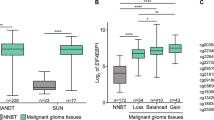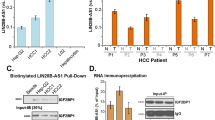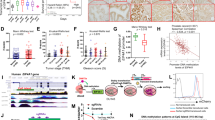Abstract
RNA-binding proteins (RBPs) have important roles in tumorigenesis. Although IGF2BP3, an evolutionally conserved RBP, has been reported as a useful diagnostic marker for various cancers and has been considered a regulator of tumorigenesis, little is known of the function of IGF2BP3 because of lack of information regarding IGF2BP3 target mRNAs. Here, we report the identification of IGF2BP3 target mRNAs and IGF2BP3 function in cancer proliferation. We identified mRNAs with altered expression in IGF2BP3-depleted cells by massive sequencing analysis and IGF2BP3-binding RNAs by immunoprecipitation of IGF2BP3 followed by massive sequencing analysis, resulting in the identification of 110 candidates that are negatively regulated by IGF2BP3. We found that IGF2BP3 destabilized EIF4E-BP2 and MEIS3 mRNAs. Co-immunoprecipitation analysis revealed the interaction between IGF2BP3 and ribonucleases such as XRN2 and exosome component. The retarded proliferation of IGF2BP3-depleted cells was partially rescued by the depletion of EIF4E-BP2, which negatively regulates eukaryotic translation initiation factor 4E (eIF4E), an activator of translation and a well-known proto-oncogene. Consistent with this observation, IGF2BP3 depletion reduced phosphorylated eIF4E, the active form, and translational efficiency of eIF4E target transcripts. Reduction of phosphorylated eIF4E by IGF2BP3 depletion was rescued by EIF4E-BP2 depletion. At last, we found an inverse correlation between the expression level of IGF2BP3 and EIF4E-BP2 in human lung adenocarcinoma tissues. Together, these results suggest that IGF2BP3 promotes eIF4E-mediated translational activation through the reduction of EIF4E-BP2 via mRNA degradation, leading to enhanced cell proliferation. This is the first report demonstrating that IGF2BP3 is an RNA-destabilizing factor. Notably, here we provide the first evidence for the functional linkage between two previously well-known cancer biomarkers, IGF2BP3 and eIF4E.
This is a preview of subscription content, access via your institution
Access options
Subscribe to this journal
Receive 50 print issues and online access
$259.00 per year
only $5.18 per issue
Buy this article
- Purchase on Springer Link
- Instant access to full article PDF
Prices may be subject to local taxes which are calculated during checkout






Similar content being viewed by others
References
Moore MJ . From birth to death: the complex lives of eukaryotic mRNAs. Science 2005; 309: 1514–1518.
Cook KB, Kazan H, Zuberi K, Morris Q, Hughes TR . RBPDB: a database of RNA-binding specificities. Nucleic Acids Res 2011; 39: D301–D308.
Lukong KE, Chang KW, Khandjian EW, Richard S . RNA-binding proteins in human genetic disease. Trends Genet 2008; 24: 416–425.
Musunuru K . Cell-specific RNA-binding proteins in human disease. Trends Cardiovasc Med 2003; 13: 188–195.
Sonenberg N, Hinnebusch AG . New modes of translational control in development, behavior, and disease. Mol Cell 2007; 28: 721–729.
Keene JD . RNA regulons: coordination of post-transcriptional events. Nat Rev Genet 2007; 8: 533–543.
Sutandy FX, Hsiao FS, Chen CS . High throughput platform to explore RNA-protein interactomes. Crit Rev Biotechnol 2015; 20: 1–9.
Zhao J, Ohsumi TK, Kung JT, Ogawa Y, Grau DJ, Sarma K et al. Genome-wide identification of polycomb-associated RNAs by RIP-seq. Mol Cell 2010; 40: 939–953.
Bhardwaj A, Myers MP, Buratti E, Baralle FE . Characterizing TDP-43 interaction with its RNA targets. Nucleic Acids Res 2013; 41: 5062–5074.
Mukherjee N, Corcoran DL, Nusbaum JD, Reid DW, Georgiev S, Hafner M et al. Integrative regulatory mapping indicates that the RNA-binding protein HuR couples pre-mRNA processing and mRNA stability. Mol Cell 2011; 43: 327–339.
Kanematsu S, Tanimoto K, Suzuki Y, Sugano S . Screening for possible miRNA-mRNA associations in a colon cancer cell line. Gene 2014; 533: 520–531.
Bell JL, Wachter K, Muhleck B, Pazaitis N, Kohn M, Lederer M et al. Insulin-like growth factor 2 mRNA-binding proteins (IGF2BPs): post-transcriptional drivers of cancer progression? Cell Mol Life Sci 2013; 70: 2657–2675.
Farina KL, Huttelmaier S, Musunuru K, Darnell R, Singer RH . Two ZBP1 KH domains facilitate beta-actin mRNA localization, granule formation, and cytoskeletal attachment. J Cell Biol 2003; 160: 77–87.
Huttelmaier S, Zenklusen D, Lederer M, Dictenberg J, Lorenz M, Meng X et al. Spatial regulation of beta-actin translation by Src-dependent phosphorylation of ZBP1. Nature 2005; 438: 512–515.
Nielsen J, Christiansen J, Lykke-Andersen J, Johnsen AH, Wewer UM, Nielsen FC . A family of insulin-like growth factor II mRNA-binding proteins represses translation in late development. Mol Cell Biol 1999; 19: 1262–1270.
Stohr N, Lederer M, Reinke C, Meyer S, Hatzfeld M, Singer RH et al. ZBP1 regulates mRNA stability during cellular stress. J Cell Biol 2006; 175: 527–534.
Mueller-Pillasch F, Lacher U, Wallrapp C, Micha A, Zimmerhackl F, Hameister H et al. Cloning of a gene highly overexpressed in cancer coding for a novel KH-domain containing protein. Oncogene 1997; 14: 2729–2733.
Wei Q, Yan J, Fu B, Liu J, Zhong L, Yang Q et al. IMP3 expression is associated with poor survival in cervical squamous cell carcinoma. Hum Pathol 2014; 45: 2218–2224.
Findeis-Hosey JJ, Yang Q, Spaulding BO, Wang HL, Xu H . IMP3 expression is correlated with histologic grade of lung adenocarcinoma. Hum Pathol 2010; 41: 477–484.
Yuan RH, Wang CC, Chou CC, Chang KJ, Lee PH, Jeng YM . Diffuse expression of RNA-binding protein IMP3 predicts high-stage lymph node metastasis and poor prognosis in colorectal adenocarcinoma. Ann Surg Oncol 2009; 16: 1711–1719.
Wagner M, Kunsch S, Duerschmied D, Beil M, Adler G, Mueller F et al. Transgenic overexpression of the oncofetal RNA binding protein KOC leads to remodeling of the exocrine pancreas. Gastroenterology 2003; 124: 1901–1914.
Jeng YM, Chang CC, Hu FC, Chou HY, Kao HL, Wang TH et al. RNA-binding protein insulin-like growth factor II mRNA-binding protein 3 expression promotes tumor invasion and predicts early recurrence and poor prognosis in hepatocellular carcinoma. Hepatology 2008; 48: 1118–1127.
Vikesaa J, Hansen TV, Jonson L, Borup R, Wewer UM, Christiansen J et al. RNA-binding IMPs promote cell adhesion and invadopodia formation. Embo J 2006; 25: 1456–1468.
Jonson L, Christiansen J, Hansen TV, Vikesa J, Yamamoto Y, Nielsen FC . IMP3 RNP safe houses prevent miRNA-directed HMGA2 mRNA decay in cancer and development. Cell Rep 2014; 7: 539–551.
Tani H, Mizutani R, Salam KA, Tano K, Ijiri K, Wakamatsu A et al. Genome-wide determination of RNA stability reveals hundreds of short-lived noncoding transcripts in mammals. Genome Res 2012; 22: 947–956.
Dowling RJ, Topisirovic I, Alain T, Bidinosti M, Fonseca BD, Petroulakis E et al. mTORC1-mediated cell proliferation, but not cell growth, controlled by the 4E-BPs. Science 2010; 328: 1172–1176.
Richter JD, Sonenberg N . Regulation of cap-dependent translation by eIF4E inhibitory proteins. Nature 2005; 433: 477–480.
Furic L, Rong L, Larsson O, Koumakpayi IH, Yoshida K, Brueschke A et al. eIF4E phosphorylation promotes tumorigenesis and is associated with prostate cancer progression. Proc Natl Acad Sci USA 2010; 107: 14134–14139.
Müller D, Lasfargues C, El Khawand S, Alard A, Schneider RJ, Bousquet C et al. 4E-BP restrains eIF4E phosphorylation. Translation 2013; 1: e25819.
Graff JR, De Benedetti A, Olson JW, Tamez P, Casero RA Jr., Zimmer SG . Translation of ODC mRNA and polyamine transport are suppressed in ras-transformed CREF cells by depleting translation initiation factor 4E. Biochem Biophys Res Commun 1997; 240: 15–20.
Nathan CO, Carter P, Liu L, Li BD, Abreo F, Tudor A et al. Elevated expression of eIF4E and FGF-2 isoforms during vascularization of breast carcinomas. Oncogene 1997; 15: 1087–1094.
Kevil CG, De Benedetti A, Payne DK, Coe LL, Laroux FS, Alexander JS . Translational regulation of vascular permeability factor by eukaryotic initiation factor 4E: implications for tumor angiogenesis. Int J Cancer 1996; 65: 785–790.
Suvasini R, Shruti B, Thota B, Shinde SV, Friedmann-Morvinski D, Nawaz Z et al. Insulin growth factor-2 binding protein 3 (IGF2BP3) is a glioblastoma-specific marker that activates phosphatidylinositol 3-kinase/mitogen-activated protein kinase (PI3K/MAPK) pathways by modulating IGF-2. J Biol Chem 2011; 286: 25882–25890.
Liao B, Hu Y, Herrick DJ, Brewer G . The RNA-binding protein IMP-3 is a translational activator of insulin-like growth factor II leader-3 mRNA during proliferation of human K562 leukemia cells. J Biol Chem 2005; 280: 18517–18524.
Hwang YS, Xianglan Z, Park KK, Chung WY . Functional invadopodia formation through stabilization of the PDPN transcript by IMP-3 and cancer-stromal crosstalk for PDPN expression. Carcinogenesis 2012; 33: 2135–2146.
Fedele M, Palmieri D, Fusco A . HMGA2: A pituitary tumour subtype-specific oncogene? Mol Cell Endocrinol 2010; 326: 19–24.
Hammerle M, Gutschner T, Uckelmann H, Ozgur S, Fiskin E, Gross M et al. Posttranscriptional destabilization of the liver-specific long noncoding RNA HULC by the IGF2 mRNA-binding protein 1 (IGF2BP1). Hepatology 2013; 58: 1703–1712.
Weidensdorfer D, Stohr N, Baude A, Lederer M, Kohn M, Schierhorn A et al. Control of c-myc mRNA stability by IGF2BP1-associated cytoplasmic RNPs. RNA 2009; 15: 104–115.
Rivera Vargas T, Boudoukha S, Simon A, Souidi M, Cuvellier S, Pinna G et al. Post-transcriptional regulation of cyclins D1, D3 and G1 and proliferation of human cancer cells depend on IMP-3 nuclear localization. Oncogene 2014; 33: 2866–2875.
Topisirovic I, Sonenberg N . mRNA translation and energy metabolism in cancer: the role of the MAPK and mTORC1 pathways. Cold Spring Harb Symp Quant Biol 2011; 76: 355–367.
Bitterman PB, Polunovsky VA . eIF4E-mediated translational control of cancer incidence. Biochim Biophys Acta 2014; 1849: 774–780.
Martineau Y, Azar R, Bousquet C, Pyronnet S . Anti-oncogenic potential of the eIF4E-binding proteins. Oncogene 2013; 32: 671–677.
Avdulov S, Li S, Michalek V, Burrichter D, Peterson M, Perlman DM et al. Activation of translation complex eIF4F is essential for the genesis and maintenance of the malignant phenotype in human mammary epithelial cells. Cancer Cell 2004; 5: 553–563.
She QB, Halilovic E, Ye Q, Zhen W, Shirasawa S, Sasazuki T et al. 4E-BP1 is a key effector of the oncogenic activation of the AKT and ERK signaling pathways that integrates their function in tumors. Cancer Cell 2010; 18: 39–51.
Hsieh AC, Costa M, Zollo O, Davis C, Feldman ME, Testa JR et al. Genetic dissection of the oncogenic mTOR pathway reveals druggable addiction to translational control via 4EBP-eIF4E. Cancer Cell 2010; 17: 249–261.
Kim YY, Von Weymarn L, Larsson O, Fan D, Underwood JM, Peterson MS et al. Eukaryotic initiation factor 4E binding protein family of proteins: sentinels at a translational control checkpoint in lung tumor defense. Cancer Res 2009; 69: 8455–8462.
Coleman LJ, Peter MB, Teall TJ, Brannan RA, Hanby AM, Honarpisheh H et al. Combined analysis of eIF4E and 4E-binding protein expression predicts breast cancer survival and estimates eIF4E activity. Br J Cancer 2009; 100: 1393–1399.
Blackinton JG, Keene JD . Post-transcriptional RNA regulons affecting cell cycle and proliferation. Semin Cell Dev Biol 2014; 34: 44–54.
Imamachi N, Tani H, Mizutani R, Imamura K, Irie T, Suzuki Y et al. BRIC-seq: a genome-wide approach for determining RNA stability in mammalian cells. Methods 2014; 67: 55–63.
Acknowledgements
We thank Dr Hiroki Kurihara, Dr Yukiko Kurihara, Dr Hiro-oki Iwakawa and Dr Yukihide Tomari (The University of Tokyo) for helpful supports and fruitful discussions. This work was financially supported by the Research Fellowship of the Japan Society for the Promotion of Science, Grant-in-Aid for Scientific Research, Grant-in-Aid for Scientific Research on Innovative Areas ‘Functional machinery for noncoding RNAs’ and ‘Genome science’ from the Ministry of Education, Culture, Sports, Science and Technology of Japan, and The Funding Program for World-Leading Innovative R&D on Science and Technology of the Japan Society for the Promotion of Science.
Author information
Authors and Affiliations
Corresponding author
Ethics declarations
Competing interests
The authors declare no conflict of interest.
Additional information
Supplementary Information accompanies this paper on the Oncogene website
Supplementary information
Rights and permissions
About this article
Cite this article
Mizutani, R., Imamachi, N., Suzuki, Y. et al. Oncofetal protein IGF2BP3 facilitates the activity of proto-oncogene protein eIF4E through the destabilization of EIF4E-BP2 mRNA. Oncogene 35, 3495–3502 (2016). https://doi.org/10.1038/onc.2015.410
Received:
Revised:
Accepted:
Published:
Issue Date:
DOI: https://doi.org/10.1038/onc.2015.410
This article is cited by
-
The multifaceted role of Fragile X-Related Protein 1 (FXR1) in cellular processes: an updated review on cancer and clinical applications
Cell Death & Disease (2024)
-
circIPO7 dissociates caprin-1 from ribosomes and inhibits gastric cancer cell proliferation by suppressing EGFR and mTOR
Oncogene (2023)
-
Comparative proteomic analysis of nuclear and cytoplasmic compartments in human cardiac progenitor cells
Scientific Reports (2022)
-
IGF2BP3 enhances the mRNA stability of E2F3 by interacting with LINC00958 to promote endometrial carcinoma progression
Cell Death Discovery (2022)
-
The regulation of protein translation and its implications for cancer
Signal Transduction and Targeted Therapy (2021)



